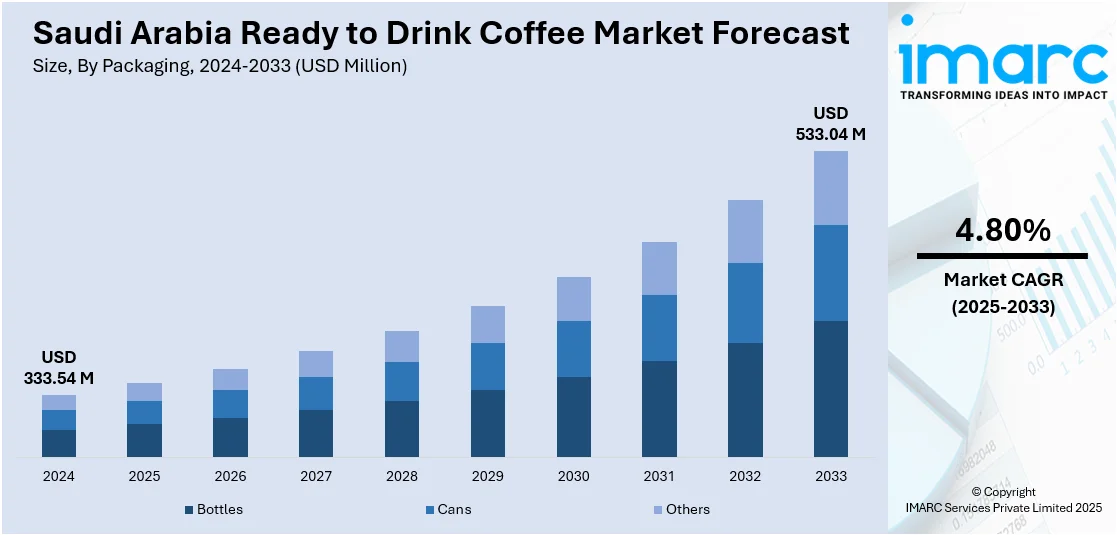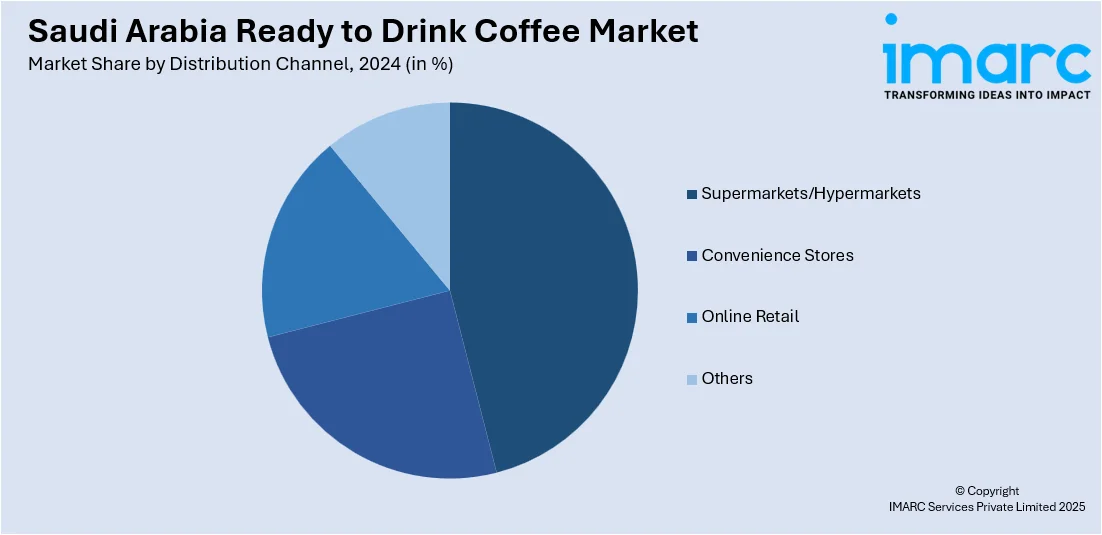
Saudi Arabia Ready to Drink Coffee Market Size, Share, Trends and Forecast by Packaging, Distribution Channel, and Region, 2025-2033
Saudi Arabia Ready to Drink Coffee Market Overview:
The Saudi Arabia ready to drink coffee market size reached USD 333.54 Million in 2024. Looking forward, IMARC Group expects the market to reach USD 533.04 Million by 2033, exhibiting a growth rate (CAGR) of 4.80% during 2025-2033. The market is driven by changing consumer lifestyles, with a strong shift toward convenience and premium beverage experiences. Busy urban professionals and a young, trend-conscious population seeking quick, high-quality coffee options that fit into their on-the-go routines is also escalating product demand. Growing exposure to international coffee trends, and government initiatives promoting local coffee production are encouraging the development of innovative, locally inspired coffee beverages across the Kingdom, which further increases the Saudi Arabia ready to drink coffee market share.
|
Report Attribute
|
Key Statistics
|
|---|---|
|
Base Year
|
2024 |
|
Forecast Years
|
2025-2033
|
|
Historical Years
|
2019-2024
|
| Market Size in 2024 | USD 333.54 Million |
| Market Forecast in 2033 | USD 533.04 Million |
| Market Growth Rate 2025-2033 | 4.80% |
Saudi Arabia Ready to Drink Coffee Market Trends:
Integration of Traditional and Contemporary Coffee Cultures
The coffee culture in Saudi Arabia is witnessing a shift, as traditional practices are increasingly getting intertwined with contemporary influences. Although "Gahwa," traditional Arabic coffee, is still a household favorite, young generations are increasingly getting exposed to varied coffee cultures. This phenomenon can be reflected in the increasing popularity of specialty coffee bars and the rollout of new, innovative coffee offerings, such as RTD cold brew offerings. The uniqueness of cold brew coffee is in its smooth taste and reduced acidity from the conventional hot brew, which appeals to consumers who desire to drink less bitter and refreshing coffee, particularly in the country's warm weather. Global players such as Starbucks and Nestlé have taken advantage of this opportunity by providing RTD cold brew beverages that combine global knowledge with local preferences, addressing the changing needs of Saudi consumers.

Health Awareness and Functional Drink Demand
With increasing health awareness among Saudi consumers, a shift toward functional drinks that deliver more than caffeine is observed. More consumers now want RTD coffee that delivers caffeine along with added health values in the form of low-calorie content, lower sugar content, and added functional ingredients such as collagen or protein. This mirrors a general desire for drinks that promote wellness overall without sacrificing taste. Brands are answering this call with new, creative flavors and formulations that target the health-oriented segment, broadening the base of consumers and drawing in those who might not otherwise be regular coffee consumers.
Initiatives and Local Production Growth
The efforts of the Saudi government are having a crucial influence on the RTD coffee industry. As part of the Vision 2030 initiative, the government initiated the "Year of Saudi Coffee 2022" campaign to boost the consumption of locally produced coffee and promote domestic production. With this program, the nation seeks to increase annually a higher-quality coffee crop and expand exports by 2040. Furthermore, the creation of the Saudi Coffee Company, with major investments, will support the national coffee production while also training entrepreneurs and farmers. These initiatives support local coffee culture and increase the variety and accessibility of RTD coffee products in the market, which further fuels the Saudi Arabia ready to drink coffee market growth.
Saudi Arabia Ready to Drink Coffee Market Segmentation:
IMARC Group provides an analysis of the key trends in each segment of the market, along with forecasts at the country and regional levels for 2025-2033. Our report has categorized the market based on packaging and distribution channel.
Packaging Insights:
- Bottles
- Cans
- Others
The report has provided a detailed breakup and analysis of the market based on the packaging. This includes bottles, cans, and others.
Distribution Channel Insights:

- Supermarkets/Hypermarkets
- Convenience Stores
- Online Retail
- Others
The report has provided a detailed breakup and analysis of the market based on the distribution channel. This includes supermarkets/hypermarkets, convenience stores, online retail, and others.
Regional Insights:
- Northern and Central Region
- Western Region
- Eastern Region
- Southern Region
The report has also provided a comprehensive analysis of all the major regional markets, which include Northern and Central Region, Western Region, Eastern Region, and Southern Region.
Competitive Landscape:
The market research report has also provided a comprehensive analysis of the competitive landscape. Competitive analysis such as market structure, key player positioning, top winning strategies, competitive dashboard, and company evaluation quadrant has been covered in the report. Also, detailed profiles of all major companies have been provided.
Saudi Arabia Ready to Drink Coffee Market News:
- In April 2025, in order to improve cooperation between the coffee industry and the halal sector and increase access to coffee products through certifications, the Saudi Coffee Company (SCC) along with the Halal Products Development Company (HPDC) announced the signing of a strategic partnership agreement. Through this strategic alliance between two Public Investment Fund (PIF) entities, SCC and HPDC will be able to investigate prospects for market expansion, information sharing, and halal certification. Cross-party collaboration is outlined in the agreement in the areas of training and development, halal certification and compliance, data and market research, workshops, and market awareness.
- In December 2024, the second Experience Center and coffee shop by JAZEAN, the Saudi Coffee Company's first consumer coffee brand, opened in AlUla, Saudi Arabia's Old Town. Offering visitors and tourists to the UNESCO World Heritage Site a carefully curated experience of the nation's centuries-old coffee traditions is the goal of the brand's first presence outside of Riyadh. The establishment provides patrons with a variety of JAZEAN's carefully chosen and expertly roasted coffees, all of which are served against the backdrop of AlUla's renowned landscape, a major cultural, touristic, and heritage destination in Saudi Arabia, in addition to educating guests about the cultivation and complex roasting processes of coffee beans.
Saudi Arabia Ready to Drink Coffee Market Report Coverage:
| Report Features | Details |
|---|---|
| Base Year of the Analysis | 2024 |
| Historical Period | 2019-2024 |
| Forecast Period | 2025-2033 |
| Units | Million USD |
| Scope of the Report |
Exploration of Historical Trends and Market Outlook, Industry Catalysts and Challenges, Segment-Wise Historical and Future Market Assessment:
|
| Packaging Covered | Bottles, Cans, Others |
| Distribution Channels Covered | Supermarkets/Hypermarkets, Convenience Stores, Online Retail, Others |
| Regions Covered | Northern and Central Region, Western Region, Eastern Region, Southern Region |
| Customization Scope | 10% Free Customization |
| Post-Sale Analyst Support | 10-12 Weeks |
| Delivery Format | PDF and Excel through Email (We can also provide the editable version of the report in PPT/Word format on special request) |
Key Questions Answered in This Report:
- How has the Saudi Arabia ready to drink coffee market performed so far and how will it perform in the coming years?
- What is the breakup of the Saudi Arabia ready to drink coffee market on the basis of packaging?
- What is the breakup of the Saudi Arabia ready to drink coffee market on the basis of distribution channel?
- What is the breakup of the Saudi Arabia ready to drink coffee market on the basis of region?
- What are the various stages in the value chain of the Saudi Arabia ready to drink coffee market?
- What are the key driving factors and challenges in the Saudi Arabia ready to drink coffee market?
- What is the structure of the Saudi Arabia ready to drink coffee market and who are the key players?
- What is the degree of competition in the Saudi Arabia ready to drink coffee market?
Key Benefits for Stakeholders:
- IMARC’s industry report offers a comprehensive quantitative analysis of various market segments, historical and current market trends, market forecasts, and dynamics of the Saudi Arabia ready to drink coffee market from 2019-2033.
- The research report provides the latest information on the market drivers, challenges, and opportunities in the Saudi Arabia ready to drink coffee market.
- Porter's five forces analysis assist stakeholders in assessing the impact of new entrants, competitive rivalry, supplier power, buyer power, and the threat of substitution. It helps stakeholders to analyze the level of competition within the Saudi Arabia ready to drink coffee industry and its attractiveness.
- Competitive landscape allows stakeholders to understand their competitive environment and provides an insight into the current positions of key players in the market.
Need more help?
- Speak to our experienced analysts for insights on the current market scenarios.
- Include additional segments and countries to customize the report as per your requirement.
- Gain an unparalleled competitive advantage in your domain by understanding how to utilize the report and positively impacting your operations and revenue.
- For further assistance, please connect with our analysts.
 Request Customization
Request Customization
 Speak to an Analyst
Speak to an Analyst
 Request Brochure
Request Brochure
 Inquire Before Buying
Inquire Before Buying




.webp)




.webp)












